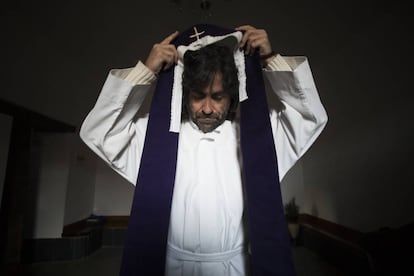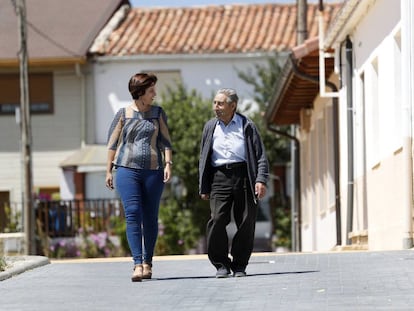Being a priest in Spain isn’t what it used to be
Depopulation in rural areas means pastors are increasingly expected to cover several parishes

“I live in an Opel Astra,” says Teo Nieto, a parish priest who covers 15 parishes single-handedly in the Aliste area of Zamora, in northwestern Spain. His car has racked up 154,922 km in three years, an average of 138 km a day. The 47-year old performs six Masses on a weekend, two on Saturday and four on Sunday, along with another six during the week, adding up to 624 Masses a year for his 1,300 parishioners.

Nieto’s labors do not end there: he also teaches religion at the Alcañices high school for 17 hours a week, the same number of hours as some of the other teachers. What’s more he also works in the afternoons and on weekends. “I’ll take a few days off between the 27th and 31st of December to relax, and then again during Carnival, providing there’s no funerals,” he says.
His lot is far from unusual in largely rural central Spain: in Salamanca, Cuenca, Segovia and Burgos, parish priests are expected to cover a lot of ground. The average number of parishes is still less than 10 per priest and often the parish is shared between two, but if things don’t change, the trend to work single-handedly and more is set to grow.
My role is not just to give communion, but to encourage, guide and inspire hope Father Teo Nieto
One of the reasons the priests spend so much time on the road is depopulation. Nieto has christened 10 children but buried 231 people since 2012. He has also christened 56 babies, but these are the children of couples who have left and only return periodically. A number of the funerals are also for former residents who wish their remains to be buried there. In the last five years, Nieto has married three couples that have settled in the area.
Another factor is that Spain is becoming more secular. In 2000, seven out of every 10 weddings were held in church, while in 2015, the number dropped to three out of 10. Christenings are also less common. Of the babies born in 2013, 21% fewer were christened than in 2005, according to the Spain’s Roman Catholic Church. But depopulation is the bigger problem: in the next 15 years, Castile and León will lose 10.7% of its inhabitants, giving it one of sthe fastest declining population in Spain, along with Asturias, according to a forecast by the National Statistics Institute (INE). Between 2010 and 2015, the number of villages in Castile and León with less than 100 residents increased from 542 to 648, says the INE, and in 2012 there were more people aged between 75 and 85 (252,124) than between 0 and 10 (210,012), according to figures from the regional government.
Fifteen years ago, there were 300 students in the Alcañices high school where Nieto gives religious instruction. Now there are 136. More than 20 of the 27 teachers commute every day from Zamora.
Teo Nieto drives around 140 kms a day
Nieto is paid by the regional government for his teaching work and gives a stipulated percentage of this salary to the diocese. Meanwhile, the Church pays a fixed amount for his petrol and helps him to buy a car on interest-free credit, at least during the first two years. And besides a modest salary, it pays for the house he lives in.
When he first arrived in Aliste, he went to visit one of his parishioners who mistook him for a beggar. “So young and already asking for food,” said the old lady.
“I used to look scruffier,” he explains. Nowadays, he sometimes wears a scarf around his neck. He describes himself as a typical of the generation that grew up in the 1980s, and event admits to having a poster of Che Guevara on the wall of his home.
The priest says he never wears a cassock, believing that it sets the priest apart from his parishioners. When members of his congregation come to visit him, he invites them into his kitchen, not his office. “The desk and chair give an impression of authority and my church is not one where the layman should be separated from the priest,” he says.

Nieto gets on well with his parishioners and sometimes gives his sermon in the aisle. According to tradition, women usually sit in the pews at the front of the church and the men behind. If most of the congregation is female, he uses the feminine form of you, vosotras, to address them.
“My role is not just to give communion,” he says. “But to encourage, guide and inspire hope.” The liturgy is only half the story.
Nieto is not sure what lies ahead for himself or the parishes of rural Spain, but he does know that should he be moved, he would ask to remain in the countryside. Sometimes locals ask him if the Catholic Church won’t send him to Zamora, the city, which for most priests would be considered a promotion. But for Nieto, it would be a step in the wrong direction.
After 20 years working the same parishes, Nieto knows each member of his congregation, though he admits to being bad with names. And as long as there’s still a small group of parishioners gathered in one place, a priest will administer to them. The smallest of Nieto’s hamlets is Tolilla, with just nine residents, but Nieto doesn’t complain. “I am at their service,” he says.
English version by Heather Galloway.
Tu suscripción se está usando en otro dispositivo
¿Quieres añadir otro usuario a tu suscripción?
Si continúas leyendo en este dispositivo, no se podrá leer en el otro.
FlechaTu suscripción se está usando en otro dispositivo y solo puedes acceder a EL PAÍS desde un dispositivo a la vez.
Si quieres compartir tu cuenta, cambia tu suscripción a la modalidad Premium, así podrás añadir otro usuario. Cada uno accederá con su propia cuenta de email, lo que os permitirá personalizar vuestra experiencia en EL PAÍS.
¿Tienes una suscripción de empresa? Accede aquí para contratar más cuentas.
En el caso de no saber quién está usando tu cuenta, te recomendamos cambiar tu contraseña aquí.
Si decides continuar compartiendo tu cuenta, este mensaje se mostrará en tu dispositivo y en el de la otra persona que está usando tu cuenta de forma indefinida, afectando a tu experiencia de lectura. Puedes consultar aquí los términos y condiciones de la suscripción digital.
More information

An old Spanish village has a strategy to attract new talent

Learning to love your village
Archived In
Últimas noticias
Most viewed
- Alain Aspect, Nobel laureate in physics: ‘Einstein was so smart that he would have had to recognize quantum entanglement’
- Mexico’s missing people crisis casts a shadow over World Cup venue
- Why oil has been at the center of Venezuela-US conflicts for decades
- Trump clarifies who is ultimately in charge in Venezuela: ‘Me’
- Mexico seeks to shore up its defenses following US incursion in Venezuela








































